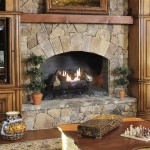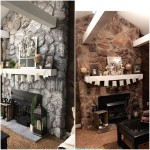Transforming a Brick Fireplace into a Stone Masterpiece
Brick fireplaces, while often charming, can sometimes feel dated or lack the desired aesthetic for a particular style. A popular alternative to a complete fireplace replacement is to paint the brick to mimic the look and texture of natural stone. This approach offers a cost-effective and relatively straightforward method to revitalize a fireplace, adding character and visual interest to the room.
Achieving a realistic stone effect on a brick fireplace requires careful planning, the right materials, and skillful application. The process involves several steps, from surface preparation to the final detailing, each contributing to the overall illusion of genuine stone. Understanding these steps and executing them properly is crucial for a successful transformation.
Key Point 1: Preparation is Paramount
The success of any painting project hinges on proper preparation, and transforming a brick fireplace to look like stone is no exception. Thorough cleaning is the initial step. Use a wire brush to remove any loose mortar, soot, or debris. Subsequently, wash the brick surface with a solution of trisodium phosphate (TSP) and water, following the manufacturer's instructions. This step removes grease, grime, and potential contaminants that could hinder paint adhesion. Rinse the brick thoroughly with clean water and allow it to dry completely, typically for at least 24 hours.
Once the brick is clean and dry, masking is essential. Use painter's tape to protect surrounding areas, such as the wall, mantel, and hearth. Drop cloths should be placed to cover the floor and any furniture near the fireplace. This meticulous masking prevents unwanted paint splatters and ensures clean lines.
Priming is crucial for optimal paint adhesion and to prevent tannins from the brick from bleeding through the paint. Apply a masonry primer specifically designed for brick surfaces. Use a brush or roller to apply an even coat of primer, ensuring all surfaces are covered. Allow the primer to dry completely according to the manufacturer's recommendations. Priming creates a uniform surface, promoting better paint adhesion and a more consistent finish.
Consider repairing any significant cracks or imperfections in the brick or mortar before priming. Use a masonry repair compound to fill in these gaps and ensure a smooth, even surface. Allow the repair compound to dry and cure according to the manufacturer’s guidelines before proceeding with priming.
Key Point 2: Achieving the Stone Effect
The core of the transformation lies in the painting technique used to create the illusion of stone. A multi-layered approach, utilizing different colors and textures, is essential for achieving a realistic effect. Start by selecting a base color that resembles the predominant color of the desired stone. Earth tones, such as beige, gray, or brown, are commonly used. Apply the base color to the entire fireplace surface using a brush or roller. Allow the base coat to dry completely.
Once the base coat is dry, begin adding texture and variation. This can be achieved using a variety of techniques, including dry brushing, sponging, and stippling. Dry brushing involves lightly dipping a brush into a contrasting color and then wiping off most of the paint onto a cloth or paper towel. The brush is then lightly dragged across the surface, leaving a subtle, textured effect. Sponging involves using a natural sea sponge to apply dabs of paint in different colors, creating a more mottled appearance. Stippling involves using a stippling brush or a similar tool to apply dots of paint, creating a textured surface.
Experiment with different colors and techniques to achieve the desired stone effect. Consider using multiple shades of the base color, as well as contrasting colors, to create depth and dimension. Observe natural stone formations to understand the variations in color and texture that occur in real stone. It is crucial to avoid a uniform or patterned application. Aim for randomness and variation to mimic the natural inconsistencies of stone.
Mortar lines play a significant role in the overall appearance. Painting the mortar lines to accentuate the stone effect is a common practice. Use a thin brush and a contrasting color, typically a lighter shade of gray or beige, to carefully paint the mortar lines. Alternatively, a mortar stain can be applied to subtly alter the mortar color. The goal is to create a visual distinction between the "stones" and the mortar, enhancing the realism of the transformation.
Key Point 3: Detailing and Finishing
The final touches are crucial for refining the stone effect and ensuring a professional-looking finish. Consider adding highlights and shadows to further enhance the depth and dimension of the “stones.” Use a small brush and a slightly lighter or darker shade of paint to subtly highlight edges and create shadows in crevices. This technique adds visual interest and makes the stone appear more three-dimensional.
Sealing the painted fireplace is essential for protecting the finish and making it easier to clean. Apply a heat-resistant sealant specifically designed for fireplaces. This sealant will protect the paint from heat damage, moisture, and soot. Follow the manufacturer's instructions for application and drying time.
Re-evaluate the overall appearance of the fireplace after sealing. Make any necessary touch-ups and adjustments to the paint or mortar lines. Ensure that the final result is visually appealing and convincingly resembles natural stone.
Remove the painter's tape and drop cloths carefully. Clean up any paint splatters or debris. Inspect the surrounding areas to ensure they are clean and undamaged. The transformed fireplace should now seamlessly integrate into the room's decor, adding character and visual appeal.
How To Paint A Red Brick Fireplace Look Like Stone

How To Paint A Red Brick Fireplace Look Like Stone

How To Paint A Red Brick Fireplace Look Like Stone

How To Paint A Red Brick Fireplace Look Like Stone

How To Paint A Red Brick Fireplace Look Like Stone Fireplaces White Wash

How To Update A Brick Fireplace With Chalk Paint Diy Beautify Creating Beauty At Home

Brick Fireplace Makeover Pine And Prospect Home

Read This Before Your Stone Fireplace Makeover Understanding Undertones

How To Cover A Brick Fireplace With Stone

See How I Made Over An Ugly Clunky Stone Veneer Fireplace With Paint
Related Posts








